
© Railway Wonders of the World 2012-


The “Trans-Canada Limited”
Across Prairie and Mountain Ranges -
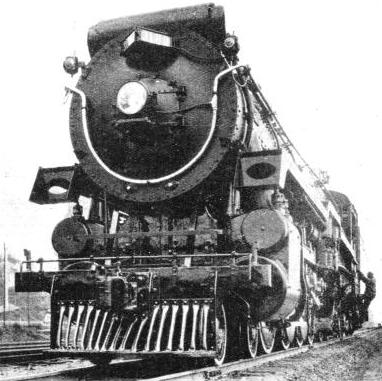
READY TO HAUL the “Trans-
PICTURE the Windsor Station at Montreal. The “Trans-
“Red-
At the head of the train is the locomotive She is a mighty monster of the 3,100 type-
From whatever aspect this superlative locomotive is viewed a feeling of awe is inspired by the triumph of engineering and design she epitomizes. Steam hisses, metal glistens, the passengers stand, held in admiration until they realize that they have only a few minutes to find their seats again. And now, with hardly a perceptible jerk, the journey has begun. It is “Au revoir Montreal!”
Montreal is not only the biggest city in Canada, but is also the commercial metropolis of the Dominion. A wonderful view of the city is seen from Mount Royal, with the broad waters of the St. Lawrence, spanned by huge bridges, in the distance.
Beyond Ottawa, the capital, the route lies through Sudbury, the centre of the world’s largest nickel deposits, discovered during the construction of the Canadian Pacific Railway. Having left Sudbury, the “Limited” will thunder through the wild and still practically uninhabited territory north of Lakes Huron and Superior. The construction of the Lake Superior section of the line presented such difficulties that the eminent engineer, William van Home, described them as “engineering impossibilities”. Their conquest is a story that ranks high in the history of railway engineering. The country to be traversed was a waste of forest, rock, and “muskegs” or swamps. Enemies of the railway declared that this portion of the line alone would require twenty years to build -

THE ROUTE of the “Trans-
It was built in four years, but the labour was terrific. Of the £2,400,000 expended on this section of two hundred miles, approximately £400,000 were spent for explosive material. It seems incredible that the cost of building some parts of the line over which the train travels was little short of £140,000 per mile.
The journey across Canada cannot fail to make the traveller appreciate the Dominion’s debt to the railway. Cities owe their very existence to this narrow band of steel that spans a continent, while thousands of acres of prairie land have been opened up for agricultural development. By Lake Superior are the famous twin cities Port Arthur and Fort William, forming the outlet through which flows the great wheat crop of Western Canada.
The railway, which has made accessible these inconceivably vast crops of grain, also handles the gigantic volume of wheat pouring in from Manitoba, Saskatchewan and Alberta. Every year the railway company masses over 40,000 box cars with a combined capacity of over 1,570,000 tons, each of these capable of carrying over 60,000,000 bushels of grain per journey. Estimating that each car will make five journeys between the grain fields and the head of the Great Lakes or Vancouver, the company is in a position to shift 300,000,000 bushels of grain during the four months of the grain rush. This calls for considerable organization, as may well be imagined. The magnitude of the concentration of the box cars can be judged when it is known that if placed end to end they would stretch for 320 miles, and that it would take the fastest trans-
 READY FOR THE NIGHT in a Canadian sleeping car. The passenger seats are slid together as shown to make the lower sleeping berth. The top berth is lowered from the roof of the coach and is accessible by means of a short step-
READY FOR THE NIGHT in a Canadian sleeping car. The passenger seats are slid together as shown to make the lower sleeping berth. The top berth is lowered from the roof of the coach and is accessible by means of a short step-
DAYTIME TRAVELLING can be enjoyed in the comfortable Pullman-
It is, of course, impossible to journey through this part of the Dominion without recalling the railway’s mighty achievements, but passengers naturally want to explore the train. They can walk right through the cars to the solarium lounge car, the last coach on the “Trans-
The comforts and the conveniences of the “Trans-
The passengers have supper in the dining-
On the evening of the next day, Fort William is reached, and already nearly a thousand miles have been covered since the departure from Montreal. Four hundred miles west of Fort William comes Winnipeg, the gateway to the Granary of the British Empire, at which the train arrives on the third day out. Little more than fifty years ago Winnipeg comprised only the frontier settlement of Fort Garry, with a population of two hundred souls clustered round the Hudson Bay Company’s post. Since the building of the CPR it has become the largest primary grain market of the world, a prosperous, populous city, and the possessor of the biggest individual railway concentration yards in existence.
Now the train is passing through endless miles of golden wheat fields, the prairie which the railway has miraculously transformed into an agricultural land of vast wealth, the home of hundreds of thousands of settlers. This is indeed the Kingdom of Wheat founded by the surveyors and pioneers of the railway. From the observation platform a great stretch of farms and grain fields, interspersed with large towns and stations surmounted by grain elevators, can be seen slowly unfolding. Regina, the Queen of the Kingdom, is the capital of the province of Saskatchewan, and the “Trans-
Gradually the prairie grows less uniform. Foothills are in evidence. Passengers begin to look out eagerly for the first faint outlines of the Rocky Mountains. These colossal ranges of towering crags formed the testing ground where the builders of the transcontinental line gave of their best. overcoming unparalleled difficulties and finally winning the applause of a whole civilization. Indeed, the mountain section of the Trans-
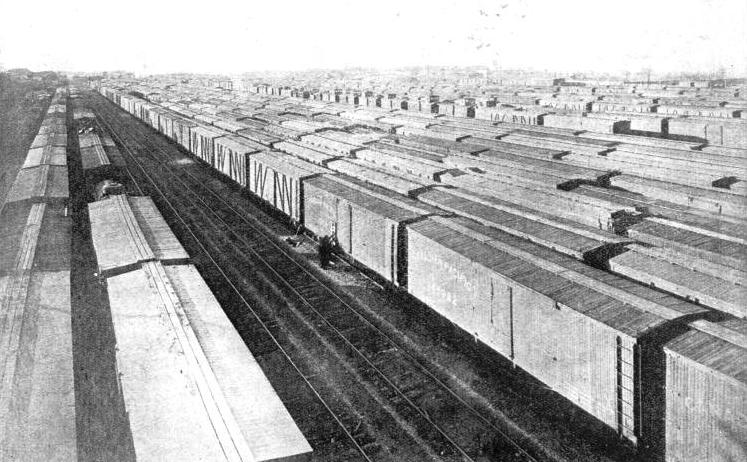
LARGEST IN THE WORLD. The Canadian Pacific Railway Co’s concentration yards at Winnipeg. The huge box cars in these immense yards, if placed in line, would extend for 320 miles. It is in these cars that the mighty grain harvests of Canada are distributed to the coast for shipment to the markets of the world.
For crossing the Rockies the locomotive is changed for a type recently introduced into the CPR’s service. This is one of the 8,000 class, built in the Company's shops at Montreal. This engine represents a new advance in the development of steam motive power towards maximum efficiency and is known as a “multi-
This locomotive has no less than ten coupled driving wheels, and a few figures illustrate its enormous size. Its overall weight is approximately 392½ tons, while the length of engine and tender combined is 99 ft 3⅜-
Gateway of the Rockies
Entering the mountains by the eastern portal, the “Gap”, the train whirls the traveller into a realm of crags and canyons, glaciers and foaming torrents; tree-
From the observation platform the onlooker is thrilled and overwhelmed by the wonderful views that flash into vision. Rearing heights, great purple chasms -
On the north side of the line, as the express emerges from the “Gap”, rears a fantastically notched and broken array of peaks, called the Fairholm Range, the greatest being known as the Grotto. To the south is seen the Goat Range, a series of massive, snow-
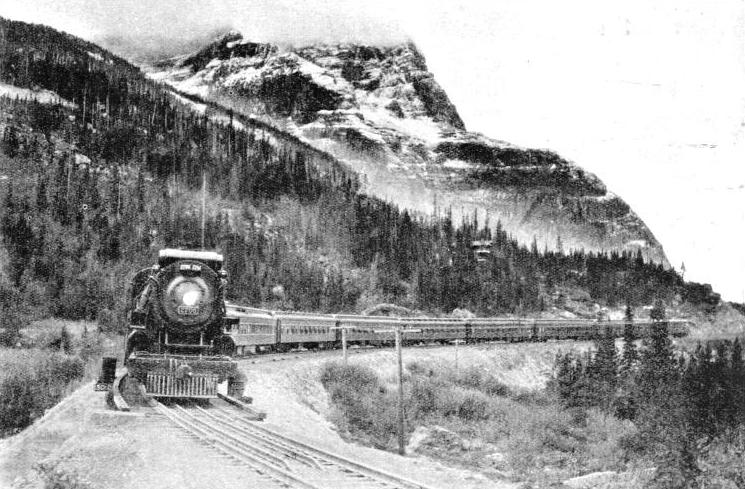
The “Trans-
From Calgary to the “Gap” the railway closely follows Bow River. Winding and climbing, the line now enters this natural approach. The climb, up is long and slow. As the rails twist tortuously in and out of crags and terraces, the engine labours to the summit at Stephen, at which point the line lies at 5,329 ft above sea level, having climbed 1,901 ft in 123 miles.
While the railway winds along the course of Bow River, between Banff and Lake Louise, dense forests, over which mountains tower on either side, can be seen from the carriage window. Far to the south the passenger has a view of the dream-
The train goes on towards the “Great Divide”, whence the waters from the glaciers separate to course down either side of the mountain before heading for the Arctic or the Pacific. It is a vast marsh and the summit was conquered without tunnelling or erecting protective snowsheds. The descent, however, falls away so suddenly that to keep the gradient within limits tunnelling was employed to a large extent. As originally planned, when time and money were scarce, a temporary line was constructed involving a steep grade of 1 in 23, for 4 miles. But when competition enforced drastic revision the route on “Big Hill”, as the climb was nicknamed, was abandoned. Instead, by an ingenious relocation of the line, including the boring of two spiral tunnels on opposite sides of the valley, the gradient has been flattened to an average of 1 in 50, at the cost of 4½ miles increase in distance.
The Spiral Tunnels
Westbound, the “Trans-
About 6,000 ft above Field, the gateway to the famous Yoho National Park, and Yoho Valley, one of the most beautiful spots in the Rockies. Mount Stephen rears skywards. At the foot of the mountain the Kicking-
The journey between Lake Louise and Field, a matter of twenty miles, brings a startling realization of the unavoidably steep gradients, and of the engineering difficulties encountered.
Westward from Field, the route runs parallel with the turbulent Kicking-
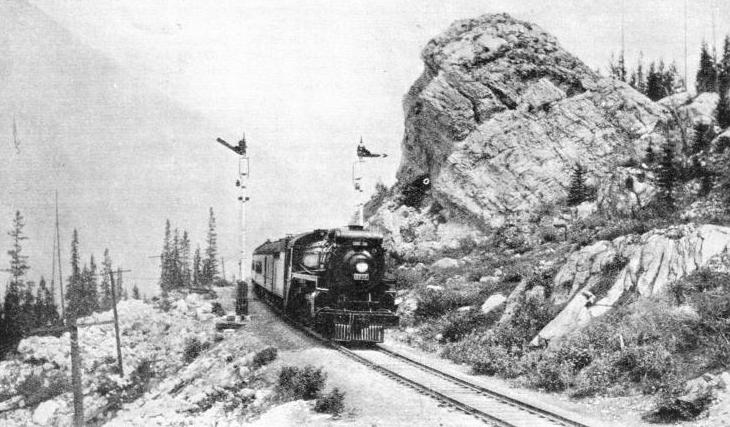
THROUGH THE ROCKIES, the express approaches Revelstoke in British Columbia. The rugged nature of the route can be discerned in this picture, which also shows the “Upper Quadrant” type of signal arm in use.
Golden comes next. It is the fourth day of the “Limited’s” journey. The traveller is now in the contrasted calm of the mighty Columbian mountains. Between Golden and Glacier, the climax of the mountain splendour reveals itself. First there is the magnificent eastern thrust of the Selkirks, a dominating array of peaks culminating in the lofty pinnacle of Sir Donald. Among bursting cascades of mountain torrents, narrow gorges, precipitous canyons and dizzy abysses, the giant train is reduced by comparison to a crawling worm of steel. Overhead, white against a clear blue sky, fly streaming pennons of smoke. Sunlight catches the slope of a mountain-
Mount Macdonald of the Selkirks lies ahead. The train will soon be passing through the longest tunnel in Canada, five miles in length from portal to portal. When the railway pioneers were con fronted by the implacable barrier of the Selkirks even local Indians could not suggest a way through. Major Rogers accordingly set out to explore. He found rivers resembling a succession of weirs, and ravine after ravine dropping sheer for several hundred feet. Rogers spent many days of perilous mountaineering before he discovered and followed a rift which led him through the great range. To-
For twenty-
Owing to the increasing volume of traffic and the competition of other lines, the company demanded that its engineers should locate another route. The problem of the gradient was finally overcome by the boring of the Connaught Tunnel. Above the crown of the bore of this tunnel there is about one mile of rock, forming the body of the peak. Fifty feet to one side of the centre line of the main work a preliminary tunnel was driven in order to facilitate and to speed up construction; by forcing galleries out at right angles from the temporary tunnel, thirty-
Having passed through this tunnel the train slackens speed prior to a halt at Glacier station.
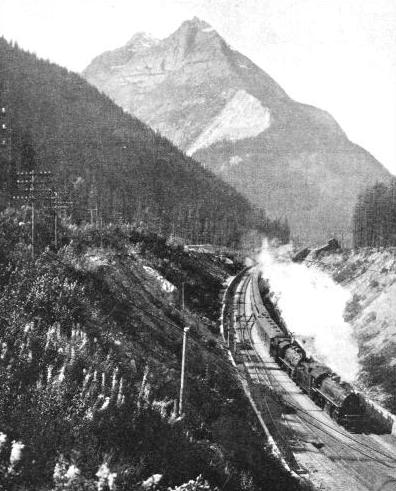 Above is the Illecillewaet glacier, a vast plateau of gleaming ice, framed in a dark forest of giant cedars, hemlock and spruce trees, scarred by crevasses, and covering an area of about ten square miles For a considerable portion of the journey, the “Trans-
Above is the Illecillewaet glacier, a vast plateau of gleaming ice, framed in a dark forest of giant cedars, hemlock and spruce trees, scarred by crevasses, and covering an area of about ten square miles For a considerable portion of the journey, the “Trans-
THE KICKING-
During the revision of the alignment after the tunnelling of Mount Macdonald, the course of the Illecillewaet River was diverted, owing to the fact that in spring, when waters are in flood, they represent a serious menace to the rails. Accordingly, the engineers had either to bridge or to divert the river. Diversion was favoured, and an embankment of 900,000 cubic yards was constructed, and a huge channel dug parallel to the track to offer a new bed.
Beyond Revelstoke the express crosses the Gold Range through Eagle Pass, where, at Craigellachie, an obelisk commemorates the completion of the Canadian Pacific Railway and the driving of the last spike of the great line. The spike was driven in at Craigellachie by the late Sir Donald Smith (Lord Strathcona) on November 7, 1885, and the first transcontinental train ran in 1886.
Vancouver is drawing steadily nearer, but there are still the Thompson River Canyons to traverse. They, in turn, lead on to the celebrated Fraser Canyon -
At Lytton the canyon widens, to admit the Fraser, the chief river of British Columbia. This river comes pouring down from the north between two great lines of mountain peaks, and its turbid flood soon engulfs the bright green waters of the Thompson. This section of the railway again exemplifies the skill and courage of the builders. The line follows the canyon at a considerable height above the river bank, while the track itself has been hewn through solid rock.
At Hell’s Gate, attention is arrested by a fine view of a spectacular cataract formed by the sudden compression of the river between two jutting promontories, whence it escapes through a bottle-
Beyond Yale, occupying a cleft above the river, in a deep recess in the mountains. Here the canyon in which the train has been travelling for so long begins to fall away, and now come the valleys through which the express swiftly sweeps on towards Vancouver. The time is nearly up, the destination at hand, and although the passengers cannot all visualize the difficulties of constructing the route which the express takes, they feel proud of the engineering triumph which has rapidly transported them over thousands of miles.
Now come the outlying districts of Vancouver. There is a considerable bustle in consequence. People begin packing their light luggage. Though they are still on the train, their journey is over. It has been a dreamlike experience, an unforgettable episode -
Here is a view of Vancouver itself. The city ranks as one of the principal ports on the western seaboard. Built on Burrard Inlet, the fully-
The great “Trans-
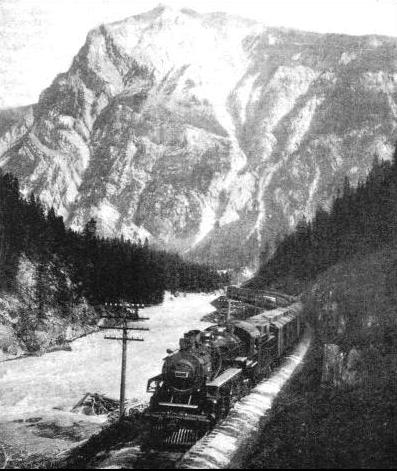
IN KICKING-
The carrying of passengers in complete comfort, even for 3,000 miles, by no means gives the full significance of the railway system over which the “Trans-
The iron-
To-
Stations such as Winnipeg have grown from rough wooden structures to magnificent buildings. The workshops at Montreal built the express locomotive pulling the “Trans-
The Call of the West
Agriculture has been and still is the basic element in the progress of the Dominion. The opening to the settlement of the seemingly limitless plains of the West was the first act in the drama that began after the actual building of the railway. Before the prairie was opened by the steel highway, Canadian agriculture was confined to the east -
Vancouver was brought into being by the Canadian Pacific Railway. Prior to its selection as the western terminus and port of the trans-
North of Quebec and Ontario a long wedge of pioneer settlement has entered into the belt lying between James Bay and the Upper Great Lakes. In Ontario and Quebec production, especially in dairy-
Besides the fostering of agriculture and mining, the railway has encouraged the vast industry of paper making and pulp. From the endless forestlands of Canada the freight engines can be seen drawing train after train of bolster wagons loaded with timber for the paper mills. The newspapers and journals of Canada and the United States provide an inexhaustible market for these mills. The railway has also assisted the widespread development of water-
But, apart from the mineral wealth brought to light, it is in the development of the agricultural regions that the importance of the railway to Canada’s prosperity has been shown.
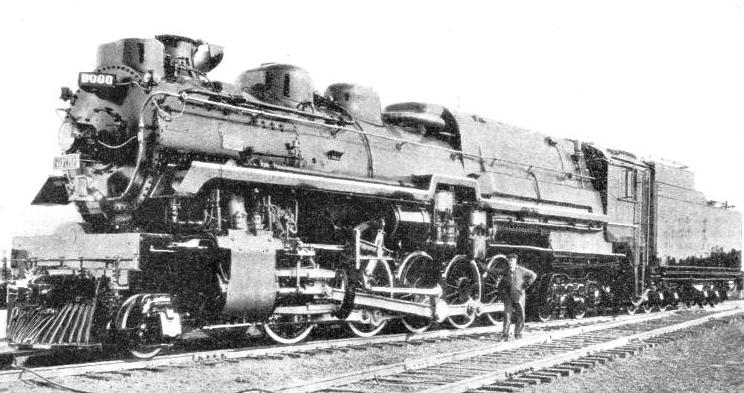
CANADIAN PACIFIC LOCOMOTIVE, No. 8000. This great engine with its ten coupled driving wheels is the largest and most powerful super-
You can read more on “The Conquest of Canada”, “The Doorway to Canada” and “The International Limited” on this website.
You can read about “Canada’s Streamlined Engines” in Wonders of World Engineering